The Fluid Evolution in the Skarn Stages of the Baoshan Skarn Cu-Polymetallic Deposit, South China
Abstract
:1. Introduction
2. Geological Setting
2.1. Regional Geology
2.2. Deposit Geology
3. Sampling and Analytical Methods
3.1. Sampling
3.2. Analytical Methods
4. Results
4.1. Petrography and Cathodoluminescence (CL)
4.2. Major and Trace Element Geochemistry of Garnet
4.3. Major Element Geochemistry of Diopside
4.4. Trace Element Geochemistry of Scheelite
5. Discussion
5.1. REE Pattern and Substitution Mechanism
5.2. Redox State of Ore-Forming Fluids
5.3. Sources and Evolution of Ore-Forming Fluids
6. Conclusions
- (1)
- In the early skarn stage of the Baoshan deposit, two generations of garnet (Grt1 and Grt2) were identified, with Grt1 having a coarse granular texture and distinct zonation, and Grt2 cutting across Grt1 as veinlets. Additionally, pyroxene in the early skarn stage coexists with Grt1 and is similarly cut by Grt2. In the late skarn stage, three generations of scheelite (Sch I, Sch II, and Sch III) were identified. Sch I and Sch II appear as anhedral to subhedral grains, while Sch III is predominantly found in veinlets.
- (2)
- In Sch I and Sch II, most of the REEs enter the scheelite lattice via the Na-REE coupled substitution mechanism, with a smaller portion entering by substituting Ca vacancies. In Sch III, the substitution mechanism involving Ca site vacancies may dominate.
- (3)
- During the early skarn stage, the oxygen fugacity of the fluid gradually decreased from Grt1 and pyroxene to Grt2. During the late skarn stage, the fluid oxygen fugacity shows little change from Sch I and Sch II to Sch III in the shallow part, while it significantly decreases from Sch I and Sch II to Sch III in the deeper part.
- (4)
- The garnet and pyroxene from the Baoshan deposit align with typical skarn Cu deposit compositions, while scheelite in the late skarn stage shows Sch I, Sch II, and shallow Sch III as skarn-type and deep Sch III as vein-type scheelite. In the early skarn stage, the pH of the ore-forming hydrothermal fluid was weakly acidic. Sch I, Sch II, and Sch III originated from the magmatic hydrothermal fluids related to the Baoshan granite porphyry. The formation of Sch III also involved water–rock interactions.
Supplementary Materials
Author Contributions
Funding
Data Availability Statement
Conflicts of Interest
References
- Brugger, J.; Etschmann, B.; Pownceby, M.; Liu, W.; Grundler, P.; Brewe, D. Oxidation state of europium in scheelite: Tracking fluid–rock interaction in gold deposits. Chem. Geol. 2008, 257, 26–33. [Google Scholar] [CrossRef]
- Fu, Y.; Hollings, P.; Li, D.; Liu, Q.; Li, S.; Sun, X. Geochemistry of multi-stage scheelite in the skarn: Constraints on ore-forming processes of the Machangqing Cu-Mo polymetallic deposit in Yunnan Province, southwest China. Ore Geol. Rev. 2021, 138, 104370. [Google Scholar] [CrossRef]
- Han, J.; Chen, H.; Hong, W.; Hollings, P.; Chu, G.; Zhang, L.; Sun, S. Texture and geochemistry of multi-stage hydrothermal scheelite in the Tongshankou porphyry-skarn Cu-Mo (-W) deposit, eastern China: Implications for ore-forming process and fluid metasomatism. Am. Mineral. 2020, 105, 945–954. [Google Scholar] [CrossRef]
- Song, G.; Cook, N.J.; Li, G.; Qin, K.; Ciobanu, C.L.; Yang, Y.; Xu, Y. Scheelite geochemistry in porphyry-skarn W-Mo systems: A case study from the Gaojiabang Deposit, East China. Ore Geol. Rev. 2019, 113, 103084. [Google Scholar] [CrossRef]
- Yuan, L.; Chi, G.; Wang, M.; Li, Z.; Xu, D.; Deng, T.; Geng, J.; Hu, M.; Zhang, L. Characteristics of REEs and trace elements in scheelite from the Zhuxi W deposit, South China: Implications for the ore-forming conditions and processes. Ore Geol. Rev. 2019, 109, 585–597. [Google Scholar] [CrossRef]
- Li, W.; Xie, G.-Q.; Mao, J.-W.; Zhang, H.-C. Mineralogy, fluid inclusion and isotope signatures: Implications for the genesis of the Early Paleozoic Yangjiashan scheelite-quartz vein deposit, South China. Ore Geol. Rev. 2021, 134, 104136. [Google Scholar] [CrossRef]
- Orhan, A. Evolution of the Mo-rich scheelite skarn mineralization at Kozbudaklar, Western Anatolia, Turkey: Evidence from mineral chemistry and fluid inclusions. Ore Geol. Rev. 2017, 80, 141–165. [Google Scholar] [CrossRef]
- Singoyi, B.; Zaw, K. A petrological and fluid inclusion study of magnetite–scheelite skarn mineralization at Kara, Northwestern Tasmania: Implications for ore genesis. Chem. Geol. 2001, 173, 239–253. [Google Scholar] [CrossRef]
- Bell, K.; Anglin, C.; Franklin, J. Sm-Nd and Rb-Sr isotope systematics of scheelites: Possible implications for the age and genesis of vein-hosted gold deposits. Geology 1989, 17, 500–504. [Google Scholar] [CrossRef]
- Guo, Z.; Li, J.; Xu, X.; Song, Z.; Dong, X.; Tian, J.; Yang, Y.; She, H.; Xiang, A.; Kang, Y. Sm-Nd dating and REE Composition of scheelite for the Honghuaerji scheelite deposit, Inner Mongolia, Northeast China. Lithos 2016, 261, 307–321. [Google Scholar] [CrossRef]
- Palmer, M.C.; Scott, J.M.; Luo, Y.; Sakar, C.; Pearson, D.G. In-situ scheelite LASS-ICPMS reconnaissance Sm-Nd isotope characterisation and prospects for dating. J. Geochem. Explor. 2021, 224, 106760. [Google Scholar] [CrossRef]
- Scanlan, E.J.; Scott, J.M.; Wilson, V.J.; Stirling, C.H.; Reid, M.R.; Le Roux, P.J. In situ 87Sr/86Sr of scheelite and calcite reveals proximal and distal fluid-rock interaction during orogenic W-Au mineralization, Otago Schist, New Zealand. Econ. Geol. 2018, 113, 1571–1586. [Google Scholar] [CrossRef]
- Song, G.; Qin, K.; Li, G.; Evans, N.J.; Chen, L. Scheelite elemental and isotopic signatures: Implications for the genesis of skarn-type W-Mo deposits in the Chizhou Area, Anhui Province, Eastern China. Am. Mineral. 2014, 99, 303–317. [Google Scholar] [CrossRef]
- Sun, K.; Chen, B. Trace elements and Sr-Nd isotopes of scheelite: Implications for the W-Cu-Mo polymetallic mineralization of the Shimensi deposit, South China. Am. Mineral. 2017, 102, 1114–1128. [Google Scholar]
- Poulin, R.S.; Kontak, D.J.; Mcdonald, A.; Mcclenaghan, M.B. Assessing scheelite as an ore-deposit discriminator using its trace-element and REE chemistry. Can. Mineral. 2018, 56, 265–302. [Google Scholar] [CrossRef]
- Sciuba, M.; Beaudoin, G.; Grzela, D.; Makvandi, S. Trace element composition of scheelite in orogenic gold deposits. Miner. Depos. 2020, 55, 1149–1172. [Google Scholar] [CrossRef]
- Gaspar, M.; Knaack, C.; Meinert, L.D.; Moretti, R. REE in skarn systems: A LA-ICP-MS study of garnets from the Crown Jewel gold deposit. Geochim. Cosmochim. Acta 2008, 72, 185–205. [Google Scholar] [CrossRef]
- Ague, J.J.; Carlson, W.D. Metamorphism as garnet sees it: The kinetics of nucleation and growth, equilibration, and diffusional relaxation. Elements 2013, 9, 439–445. [Google Scholar] [CrossRef]
- Bian, X.L.; Zhang, J.; Wang, J.L.; Liu, C.F.; Yu, H.J. In situ analysis of garnets from the Hongshan skarn copper depositin Northwest Yunnan Province and its geological implications. Acta Petrol. Sin. 2019, 35, 1463–1477, (In Chinese with English Abstract). [Google Scholar]
- Meinert, L.D. Skarns and skarn deposits. Geosci. Can. 1992, 19, 145–162. [Google Scholar]
- Meinert, L.D. Compositional variation of igneous rocks associated with skarn deposits-chemical evidence for a genetic connection between petrogenesis and mineralization. Mineral. Assoc. Can. Short Course Ser. 1995, 23, 401–418. [Google Scholar]
- Chen, K.; Shao, Y.J.; Zhang, J.K.; Zhang, Y.; Tan, H.J.; Zhang, Y.C.; Liu, Z.F. Garnet U-Pb geochronology and geochemistry reveal deposit types and fluid evolution: An example from the Dongguashan Cu-Au deposit, eastern China. Ore Geol. Rev. 2022, 145, 104883. [Google Scholar] [CrossRef]
- Yu, F.; Shu, Q.; Niu, X.; Xing, K.; Li, L.; Lentz, D.R.; Zeng, Q.; Yang, W. Composition of garnet from the Xianghualing Skarn Sn Deposit, South China: Its petrogenetic significance and exploration potential. Minerals 2020, 10, 456. [Google Scholar] [CrossRef]
- Duan, X.X.; Ju, Y.F.; Chen, B.; Wang, Z.Q. Garnet Geochemistry of Reduced Skarn System: Implications for Fluid Evolution and Skarn Formation of the Zhuxiling W (Mo) Deposit, China. Minerals 2020, 10, 1024. [Google Scholar] [CrossRef]
- Ding, T.; Tan, T.T.; Wang, J.; Ma, D.S.; Lu, J.J.; Zhang, R.Q.; Liang, J. Trace-element composition of pyrite in the Baoshan Cu-Mo-Pb-Zn deposit, southern Hunan Province, China: Insights into the ore genesis. Ore Geol. Rev. 2022, 147, 104989. [Google Scholar] [CrossRef]
- Ding, T.; Tan, T.; Wang, J.; Ma, D.; Lu, J.; Zhang, R.; Liang, J.; Wu, B. Multiple sources for the Baoshan polymetallic Cu-Mo-Pb-Zn deposit, southern Hunan Province, China: Insights from in situ LA-MC-ICP-MS sulfur isotopic compositions. Ore Geol. Rev. 2022, 143, 104808. [Google Scholar] [CrossRef]
- Hu, T.Y.; Liu, L.; Zhou, W.J.; Shao, Y.J.; Li, H.; Liu, Z.F.; Cao, L.; Xu, G.F.; Li, J.X. Contributions of trans-magmatic fluid in the formation of porphyry copper deposits: A case study from the Baoshan deposit, South China. Geochemistry 2022, 82, 125881. [Google Scholar] [CrossRef]
- Huang, W.T.; Liang, H.Y.; Zhang, J.; Wu, J.; Chen, X.L.; Ren, L. Genesis of the Dachang Sn-polymetallic and Baoshan Cu ore deposits, and formation of a Cretaceous Sn-Cu ore belt from southwest China to western Myanmar. Ore Geol. Rev. 2019, 112, 103030. [Google Scholar] [CrossRef]
- Ren, L.; Sun, J.; Han, J.; Liu, Y.; Wang, C.; Gu, A.; Zhao, K.; Yu, R. Magmatism and metallogenic mechanisms of the Baoshan Cu-polymetallic deposit from the Lesser Xing’an Range, NE China: Constraints from geology, geochronology, geochemistry, and Hf isotopes. Ore Geol. Rev. 2017, 88, 270–288. [Google Scholar] [CrossRef]
- Xie, Y.C.; Lu, J.J.; Yang, P.; Ma, D.S.; Xu, Z.W.; Zhang, R.Q.; Cai, Y.; Ding, T. S, Pb, C and O isotopic characteristics and sources of metallogenic materials of Baoshan Pb–Zn deposit, southern Huanan Province. Miner. Depos. 2015, 34, 333–351. [Google Scholar]
- Xie, Y.C.; Lu, J.J.; Ma, D.S.; Zhang, R.Q.; Gao, J.F.; Yao, Y. Origin of granodiorite porphyry and mafic microgranular enclave in the Baoshan Pb-Zn polymetallic deposit, southern Hunan Province: Zircon U-Pb chronological, geochemical and Sr-Nd-Hf isotopic constraints. Acta Petrol. Sin. 2013, 29, 4186–4214. [Google Scholar]
- Zhang, J.K.; Shao, Y.J.; Chen, K.; Tan, H.J.; Tan, R.C.; Zhang, T.D.; Liu, Z.F. Evidence of fluid evolution of Baoshan Cu-Pb-Zn polymetallic deposit: Constraints from in-situ sulfur isotope and trace element compositions of pyrite. Trans. Nonferrous Met. Soc. China 2021, 31, 3530–3548. [Google Scholar] [CrossRef]
- Zhao, W.W.; Zhou, M.-F. Mineralogical and metasomatic evolution of the Jurassic Baoshan scheelite skarn deposit, Nanling, South China. Ore Geol. Rev. 2018, 95, 182–194. [Google Scholar] [CrossRef]
- Mao, J.W.; Chen, M.H.; Yuan, S.D.; Guo, C.L. Geological Characteristics of the Qinhang (or Shihang) Metallogenic Belt in South China and Spatia-l Temporal Distribution Regularity of Mineral Deposits. Acta Geol. Sin. 2011, 85, 636–658, (In Chinese with English Abstract). [Google Scholar]
- Kong, H.; Li, H.; Wu, Q.H.; Xi, X.S.; Dick, J.M.; Gabo-Ratio, J.a.S. Co-development of Jurassic I-type and A-type granites in southern Hunan, South China: Dual control by plate subduction and intraplate mantle upwelling. Geochemistry 2018, 78, 500–520. [Google Scholar] [CrossRef]
- Zhou, X.M.; Sun, T.; Shen, W.Z.; Shu, L.S.; Niu, Y.L. Petrogenesis of Mesozoic granitoids and volcanic rocks in South China: A response to tectonic evolution. Episodes 2006, 29, 26–33. [Google Scholar] [CrossRef]
- Mi, J.R.; Yuan, S.D.; Xuan, Y.S.; Zhang, D.L. Zircon U-Pb ages, Hf isotope and trace element characteristics of the granodiorite porphyry from the Baoshan-Dafang ore district, Hunan: Implications for regional metallogeny. Acta Petrol. Sin. 2018, 34, 2548–2564. [Google Scholar]
- Zhao, P.L.; Yuan, S.D.; Mao, J.W.; Santosh, M.; Zhang, D.L. Zircon U–Pb and Hf–O isotopes trace the architecture of polymetallic deposits: A case study of the Jurassic ore-forming porphyries in the Qin–Hang metallogenic belt, China. Lithos 2017, 292, 132–145. [Google Scholar] [CrossRef]
- Hacker, B.R.; Ratschbacher, L.; Webb, L.; Ireland, T.; Walker, D.; Shuwen, D. U/Pb zircon ages constrain the architecture of the ultrahigh-pressure Qinling–Dabie Orogen, China. Earth Planet. Sci. Lett. 1998, 161, 215–230. [Google Scholar] [CrossRef]
- Cawood, P.A. Terra Australis Orogen: Rodinia breakup and development of the Pacific and Iapetus margins of Gondwana during the Neoproterozoic and Paleozoic. Earth-Sci. Rev. 2005, 69, 249–279. [Google Scholar] [CrossRef]
- Fan, W.; Wang, Y.; Zhang, A.; Zhang, F.; Zhang, Y. Permian arc–back-arc basin development along the Ailaoshan tectonic zone: Geochemical, isotopic and geochronological evidence from the Mojiang volcanic rocks, Southwest China. Lithos 2010, 119, 553–568. [Google Scholar] [CrossRef]
- Zhang, Y.Q.; Xu, X.B.; Jia, D.; Shu, L.S. Deformation record of the change from Indosinian collision-related tectonic system to Yanshanian subduction-related tectonic system in South China during the Early Mesozoic. Earth Sci. Front. 2009, 16, 234–247, (In Chinese with English abstract). [Google Scholar]
- Li, D.F.; Tan, C.Y.; Miao, F.Y.; Liu, Q.F.; Zhang, Y.; Sun, X.M. Initiation of Zn-Pb mineralization in the Pingbao Pb-Zn skarn district, South China: Constraints from U-Pb dating of grossular-rich garnet. Ore Geol. Rev. 2019, 107, 587–599. [Google Scholar] [CrossRef]
- Hou, Z.Q.; Pan, X.F.; Li, Q.Y.; Yang, Z.M.; Song, Y.C. The giant Dexing porphyry Cu-Mo-Au deposit in east China: Product of melting of juvenile lower crust in an intracontinental setting. Miner. Depos. 2013, 48, 1019–1045. [Google Scholar] [CrossRef]
- Hou, Z.Q.; Yang, Z.M.; Wang, R.; Zheng, Y.C. Further discussion on porphyry Cu-Mo-Au deposit formation in Chinese mainland. Earth Sci. Front. (China Univ. Geosci. Beijing) 2020, 27, 020–044, (In Chinese with English Abstract). [Google Scholar]
- Hua, R.M.; Chen, P.R.; Zhang, W.L.; Yao, J.M.; Lin, J.F.; Zhang, Z.S.; Gu, S.Y. Metallogeneses and Their Geodynamic Settings Related to Mesozoic Granitoids in the Nanling Range. Geol. J. China Univ. 2005, 11, 291, (In Chinese with English Abstract). [Google Scholar]
- Zhao, Z.H.; Bao, Z.W.; Zhang, B.Y. Geochemistry of the Mesozoic basaltic rocks in southern Hunan Province. Sci. China Ser. D Earth Sci. 1998, 41, 102–112. [Google Scholar] [CrossRef]
- Kong, H.; Quan, T.J.; Xi, X.S.; Zhong, J.L.; Chen, Z.F.; Wang, G.; Guo, B.Y.; Zhao, Z.Q. Geochemical characteristics of lamprophyre and its geological significance in Baoshan deposit, Hunan province, China. Chin. J. Nonferrous Met. 2013, 23, 2671–2682, (In Chinese with English Abstract). [Google Scholar]
- Lu, Y.F.; Ma, L.Y.; Qu, W.J.; Mel, Y.P.; Chen, X.Q. U-Pb and Re-Os isotope geochronology of Baoshan Cu-Mo polymetallic ore deposit in Hunan province. Acta Petrol. Sin. 2006, 22, 2483–2492, (In Chinese with English Abstract). [Google Scholar]
- Zhang, J.K.; Shao, Y.J.; Liu, Z.F.; Chen, K. Sphalerite as a record of metallogenic information using multivariate statistical analysis: Constraints from trace element geochemistry. J. Geochem. Explor. 2022, 232, 106883. [Google Scholar] [CrossRef]
- Li, H.; Kong, H.; Zhou, Z.-K.; Wu, Q.-H.; Xi, X.-S.; Gabo-Ratio, J.a.S. Ore-forming material sources of the Jurassic Cu-Pb-Zn mineralization in the Qin-Hang ore belt, South China: Constraints from S-Pb isotopes. Geochemistry 2019, 79, 280–306. [Google Scholar] [CrossRef]
- Reed, W.P. Certificate of Analysis: Standard Reference Materials 610 and 611; National Institute of Standards and Technology: Gaithersburg, MD, USA, 1992. [Google Scholar]
- Liu, Y.S.; Hu, Z.C.; Shan, G.; Günther, D.; Xu, J. In situ analysis of major and trace elements of anhydrous minerals by LA-ICP-MS without applying an internal standard. Chem. Geol. 2008, 257, 34–43. [Google Scholar] [CrossRef]
- Meinert, L.D. World skarn deposits. In Economic Geology 100th Anniversary Volume; Society of Economic Geologists, Inc.: Littleton, Co, USA, 2005; pp. 236–299. [Google Scholar]
- Sun, S.S.; Mcdonough, W.F. Chemical and isotopic systematics of oceanic basalts: Implications for mantle composition and processes. Geol. Soc. Lond. Spec. Publ. 1989, 42, 313–345. [Google Scholar] [CrossRef]
- Ghaderi, M.; Palin, J.M.; Campbell, I.H.; Sylvester, P.J. Rare earth element systematics in scheelite from hydrothermal gold deposits in the Kalgoorlie-Norseman region, Western Australia. Econ. Geol. 1999, 94, 423–437. [Google Scholar] [CrossRef]
- Yao, J.M.; Hua, R.M.; Lin, J.F. REE, Pb-S Isotope Geochemistry, and Rb-Sr Isochron Age of Pyrites in the Baoshan Deposit, South Hunan Province, China. Acta Geol. Sin. 2006, 80, 1045–1054, (In Chinese with English Abstract). [Google Scholar]
- Zhan, Q.; Gao, X.-Y.; Meng, L.; Zhao, T.-P. Ore genesis and fluid evolution of the Sandaozhuang supergiant W-Mo skarn deposit, southern margin of the North China Craton: Insights from scheelite, garnet and clinopyroxene geochemistry. Ore Geol. Rev. 2021, 139, 104551. [Google Scholar] [CrossRef]
- Li, S.T. Characteristics and Genesis of the Yaogangxian Tungsten Polymetallic Deposits in Hunan Province. Ph.D. Thesis, China University of Geosciences (Beijing), Beijing, China, 2011. (In Chinese with English Abstract). [Google Scholar]
- Feng, C.Y.; Wang, S.; Li, G.C.; Ma, S.C.; Li, D.S. Middle to Late Triassic granitoids in the Qimantage area, Qinghai Province, China: Chronology, geochemistry and metallogenic significances. Acta Petrol. Sin. 2012, 28, 665–678, (In Chinese with English Abstract). [Google Scholar]
- Zhang, R.Q. Petrogenesis and Metallogeny of the W- and Sn-Bearing Granites in Southern Hunan Province: Case Study from Wangxianling and Xintianling. Ph.D. Thesis, Nanjing University, Nanjing, China, 2015. (In Chinese with English Abstract). [Google Scholar]
- Ding, T.; Ma, D.S.; Lu, J.J.; Zhang, R.Q. Garnet and scheelite as indicators of multi-stage tungsten mineralization in the Huangshaping deposit, southern Hunan province, China. Ore Geol. Rev. 2018, 94, 193–211. [Google Scholar] [CrossRef]
- Zhao, L.J.; Zhang, Y.; Shao, Y.J.; Li, H.B.; Shah, S.A.; Zhou, W.J. Using garnet geochemistry discriminating different skarn mineralization systems: Perspective from Huangshaping W-Mo-Sn-Cu polymetallic deposit, South China. Ore Geol. Rev. 2021, 138, 104412. [Google Scholar] [CrossRef]
- Zhang, D.; Pan, J.; Gao, J.; Dai, T.; Bayless, R.C. In situ LA ICP-MS analysis of trace elements in scheelite from the Xuefeng Uplift Belt, South China and its metallogenic implications. Ore Geol. Rev. 2021, 133, 104097. [Google Scholar] [CrossRef]
- Qi, H.; Yang, X.; Lu, S.; Tang, C.; Cao, J.; Zhao, L.; Deng, J.; Sun, C.; Zhao, Z.; Lee, I. Ore genesis and fluid evolution of the Qiaomaishan Cu–W deposit, in the Middle-Lower Yangtze River Metallogenic Belt: Evidence from in situ analyses of apatite and scheelite. Ore Geol. Rev. 2020, 127, 103864. [Google Scholar] [CrossRef]
- Sun, K.; Chen, B.; Deng, J. Ore genesis of the Zhuxi supergiant W-Cu skarn polymetallic deposit, South China: Evidence from scheelite geochemistry. Ore Geol. Rev. 2019, 107, 14–29. [Google Scholar] [CrossRef]
- Zhang, Y.; Ma, D.; Gao, J.-F. Origin and evolution of ore-forming fluids in a tungsten mineralization system, Middle Jiangnan orogenic belt, South China: Constraints from in-situ LA-ICP-MS analyses of scheelite. Ore Geol. Rev. 2020, 127, 103806. [Google Scholar] [CrossRef]
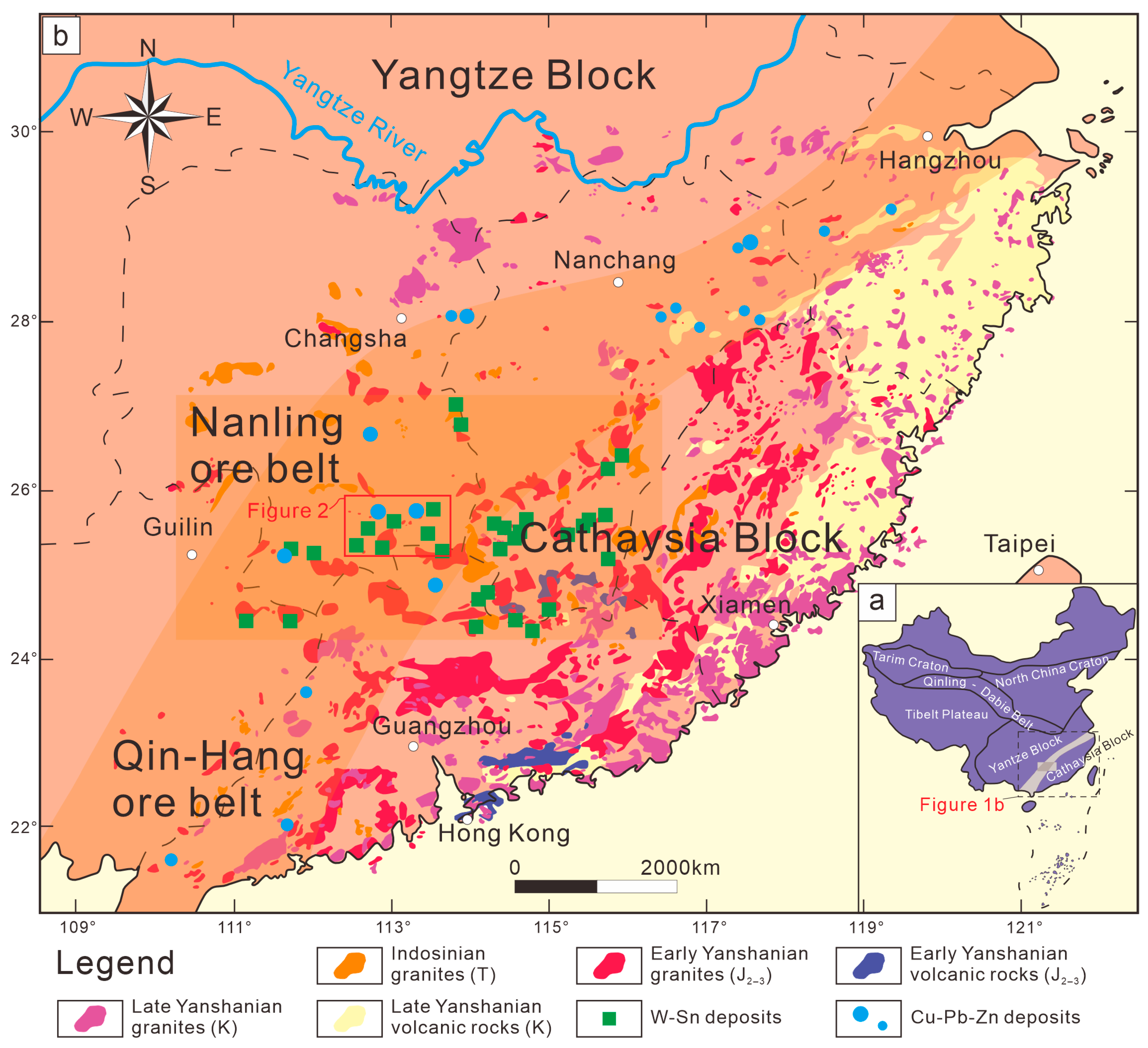

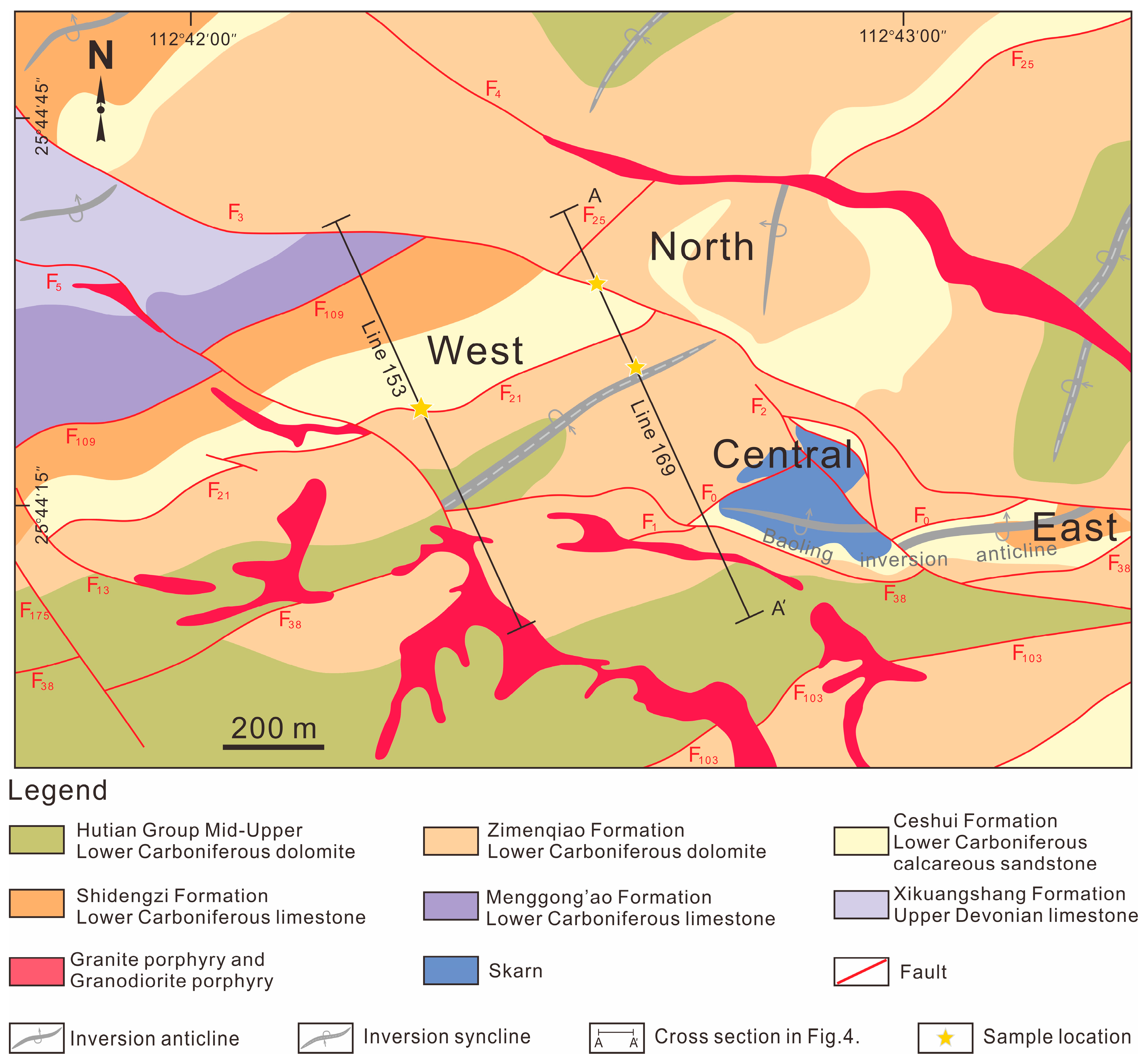


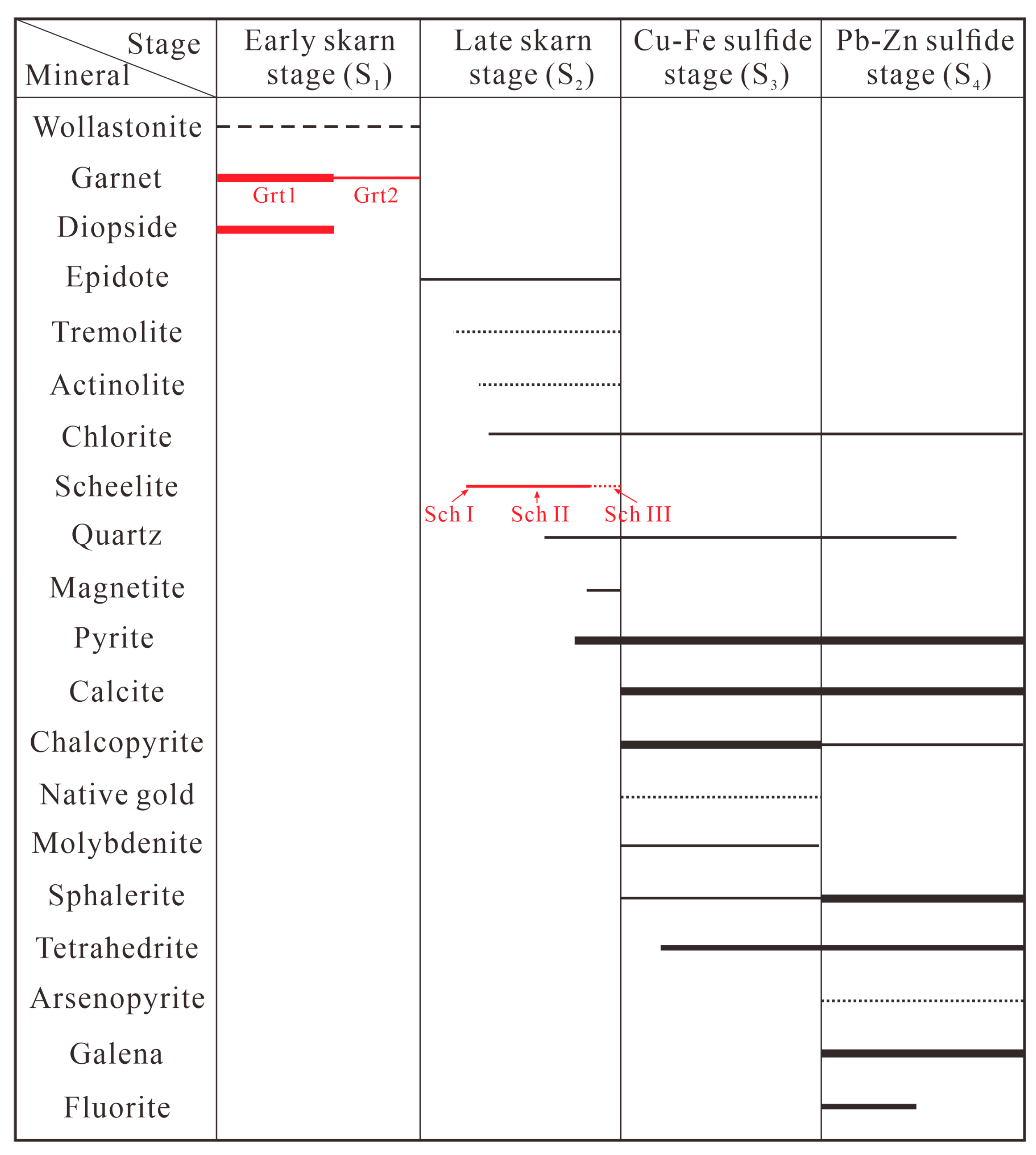
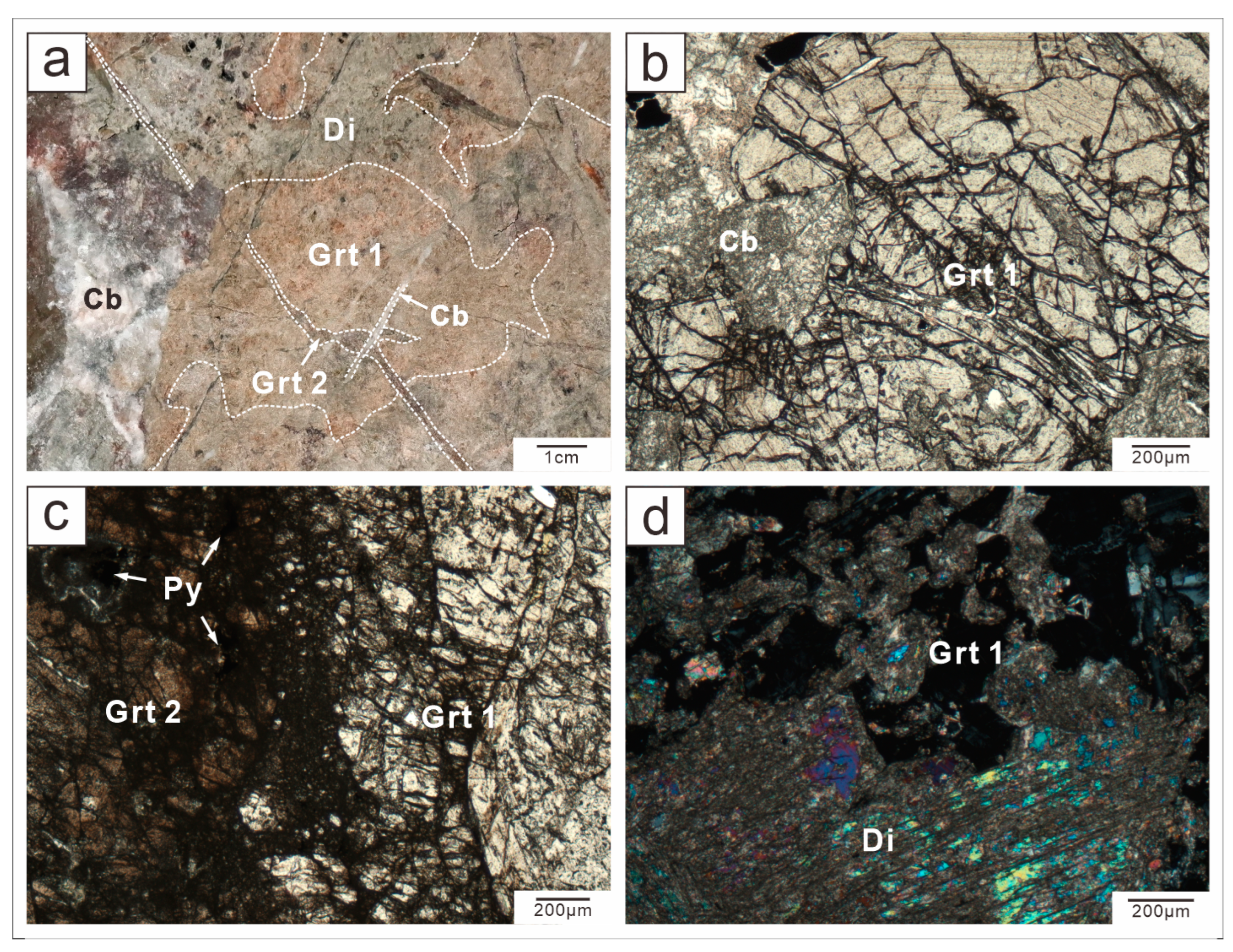
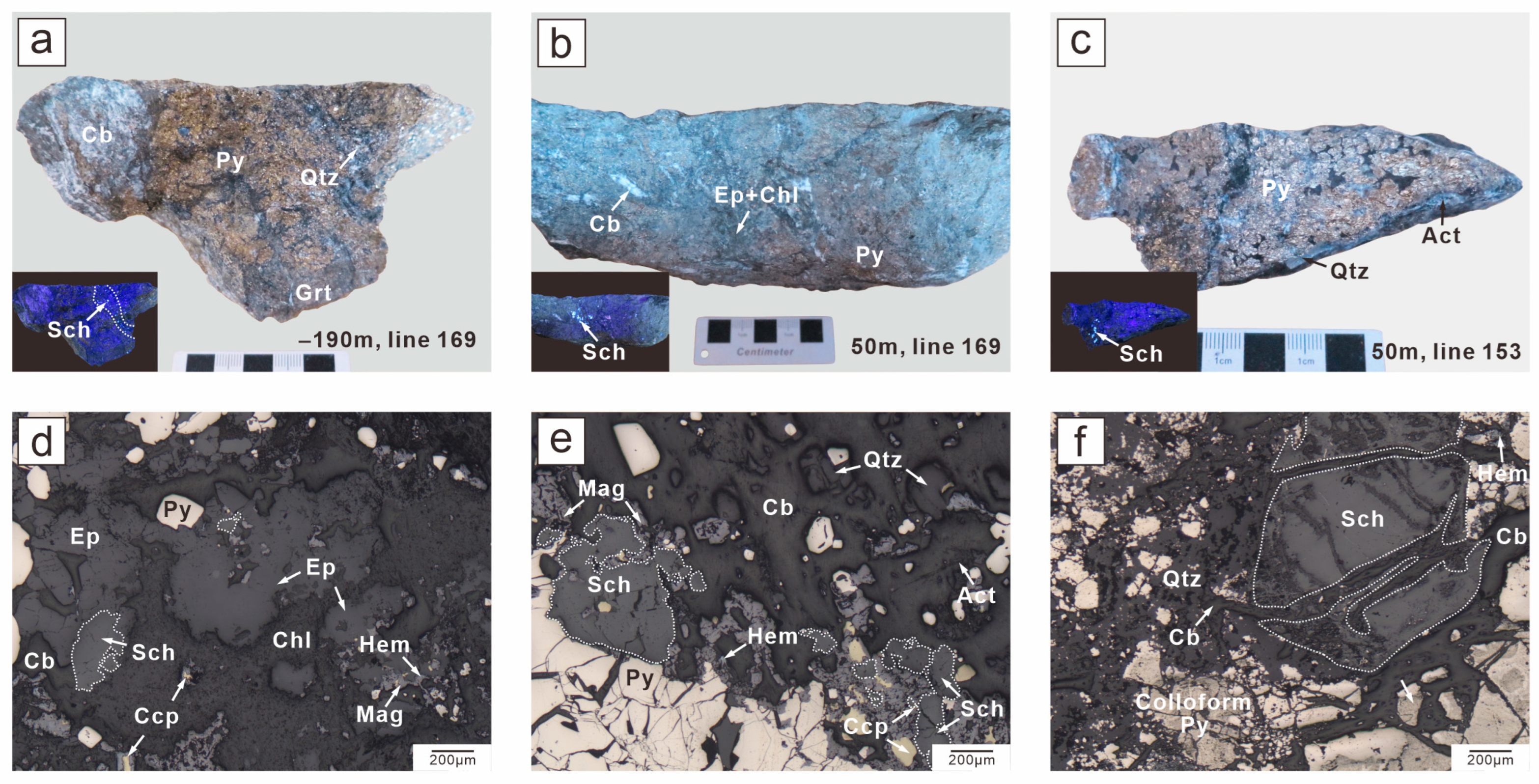

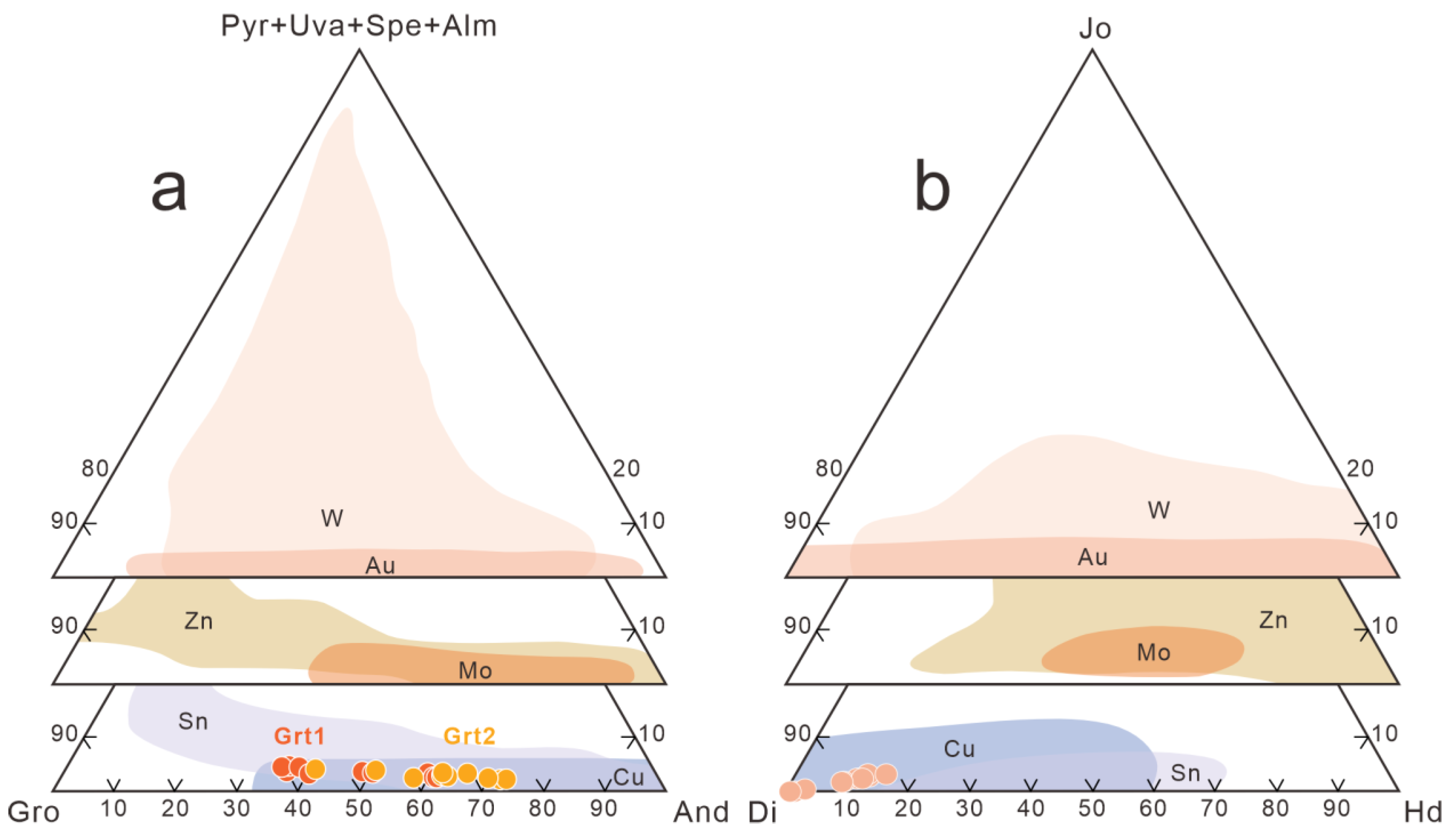
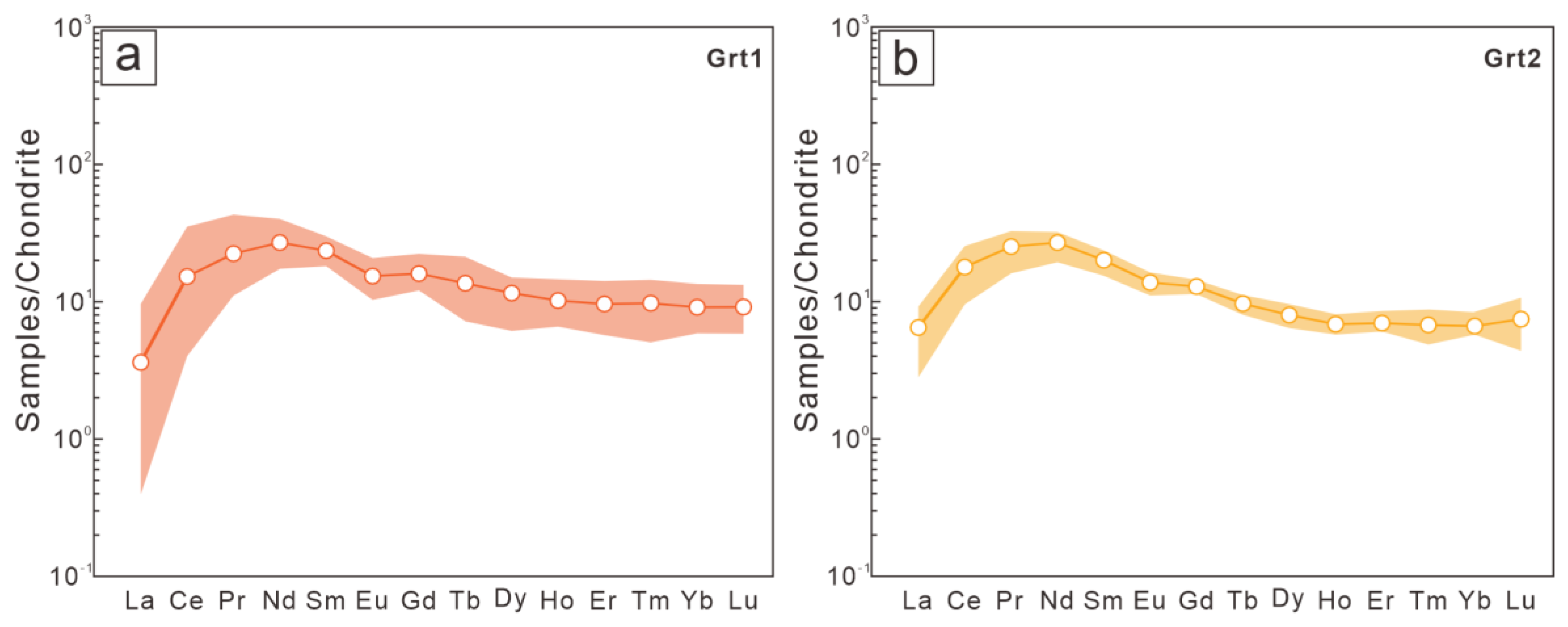

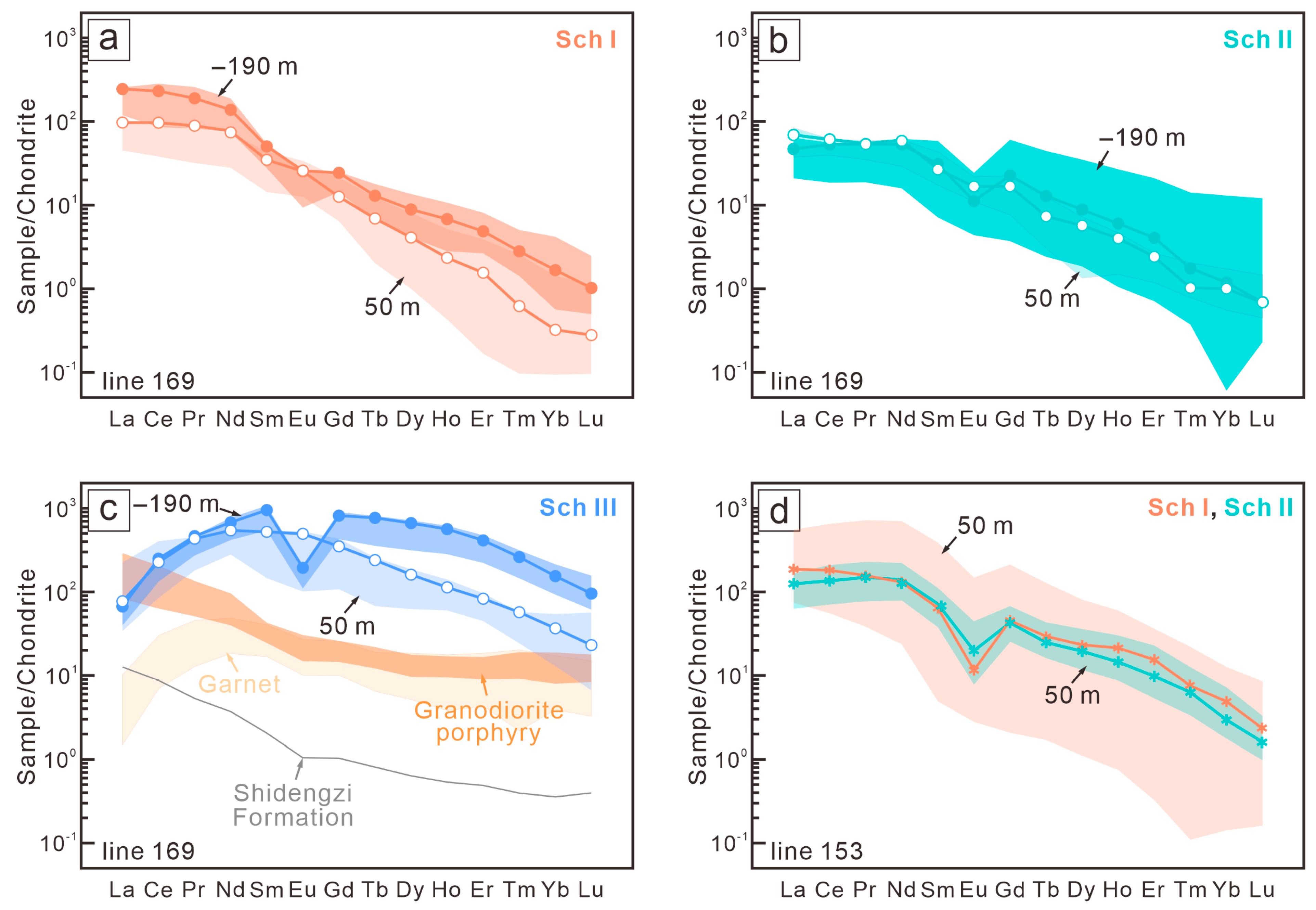


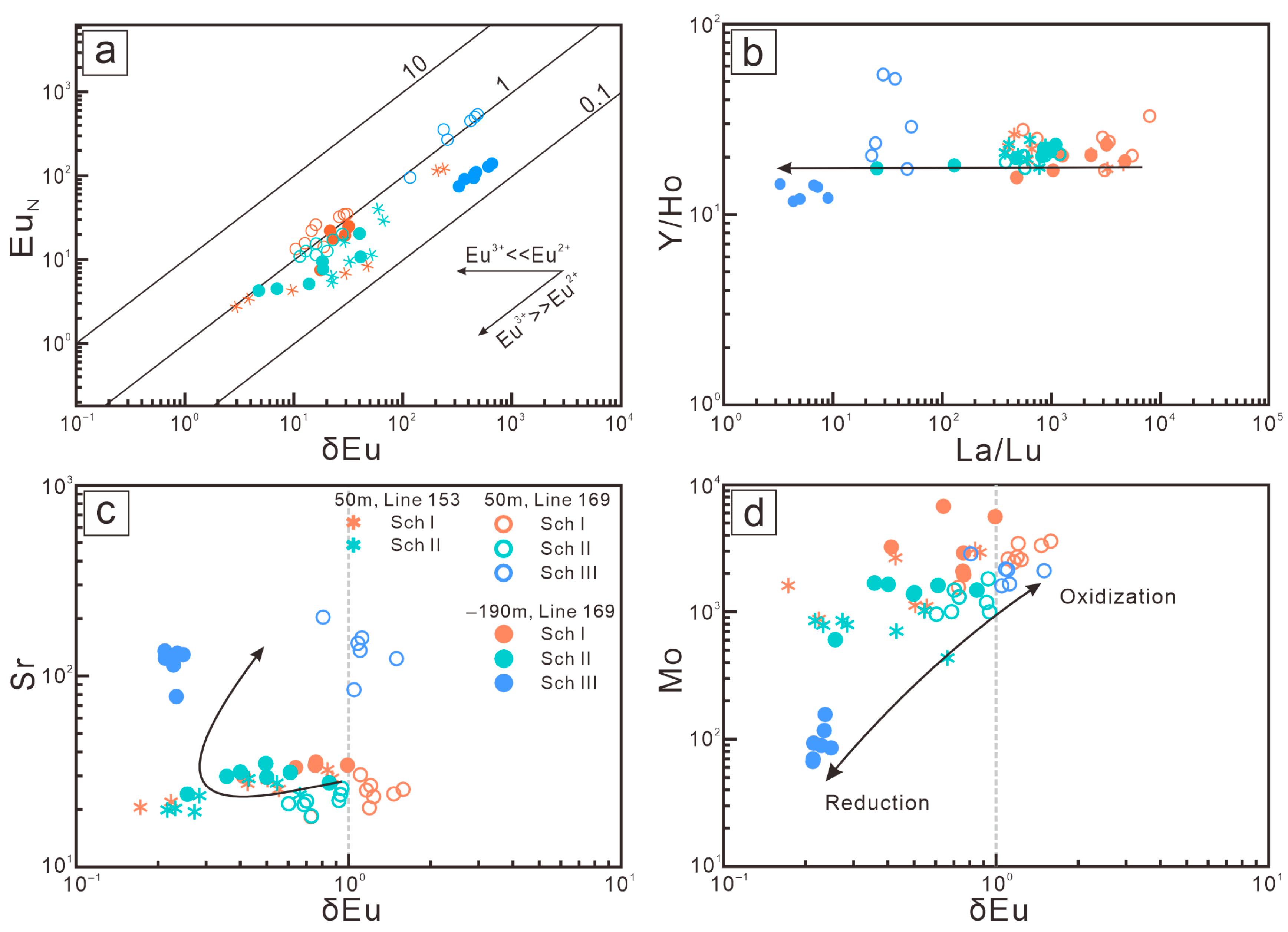
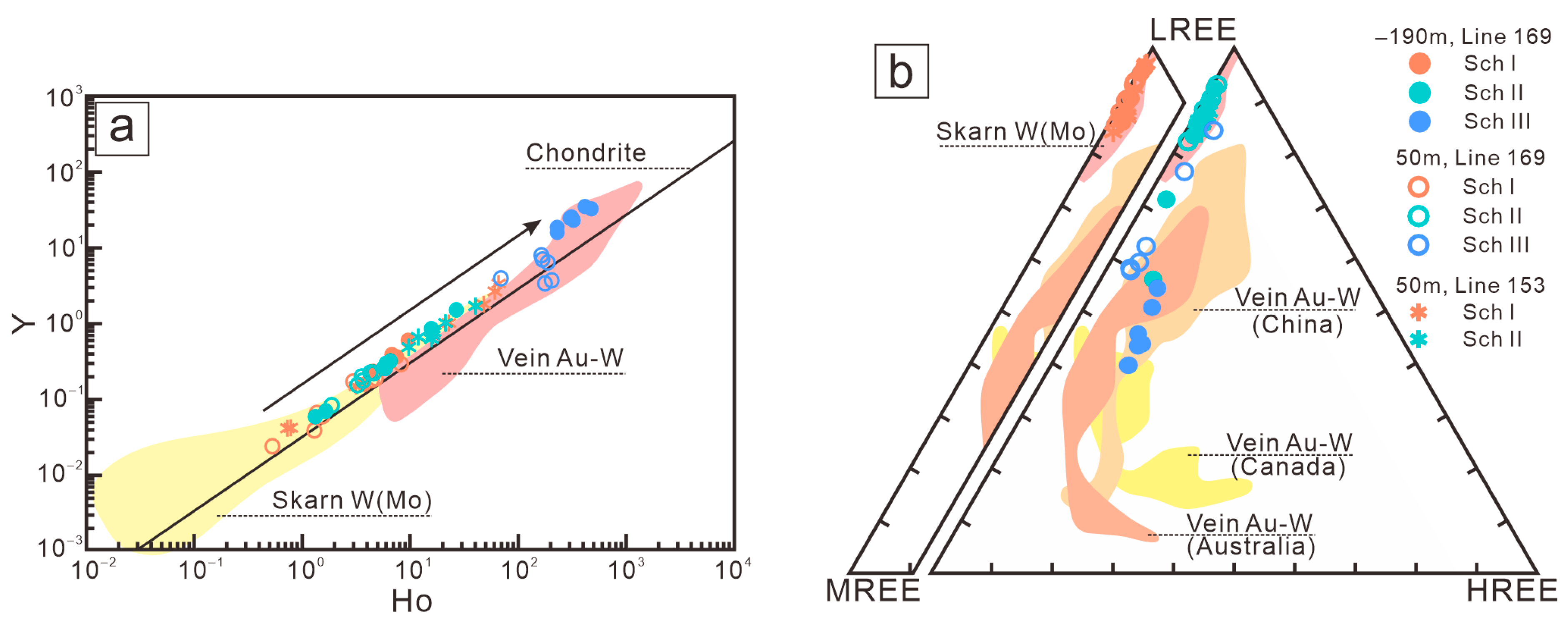
Disclaimer/Publisher’s Note: The statements, opinions and data contained in all publications are solely those of the individual author(s) and contributor(s) and not of MDPI and/or the editor(s). MDPI and/or the editor(s) disclaim responsibility for any injury to people or property resulting from any ideas, methods, instructions or products referred to in the content. |
© 2024 by the authors. Licensee MDPI, Basel, Switzerland. This article is an open access article distributed under the terms and conditions of the Creative Commons Attribution (CC BY) license (https://creativecommons.org/licenses/by/4.0/).
Share and Cite
Zheng, P.; Chen, K.; Zhang, J.-K.; Liu, Z.-F.; Li, Y.-S.; He, M.-P. The Fluid Evolution in the Skarn Stages of the Baoshan Skarn Cu-Polymetallic Deposit, South China. Minerals 2024, 14, 907. https://doi.org/10.3390/min14090907
Zheng P, Chen K, Zhang J-K, Liu Z-F, Li Y-S, He M-P. The Fluid Evolution in the Skarn Stages of the Baoshan Skarn Cu-Polymetallic Deposit, South China. Minerals. 2024; 14(9):907. https://doi.org/10.3390/min14090907
Chicago/Turabian StyleZheng, Ping, Ke Chen, Jun-Ke Zhang, Zhong-Fa Liu, Yong-Shun Li, and Ming-Peng He. 2024. "The Fluid Evolution in the Skarn Stages of the Baoshan Skarn Cu-Polymetallic Deposit, South China" Minerals 14, no. 9: 907. https://doi.org/10.3390/min14090907





